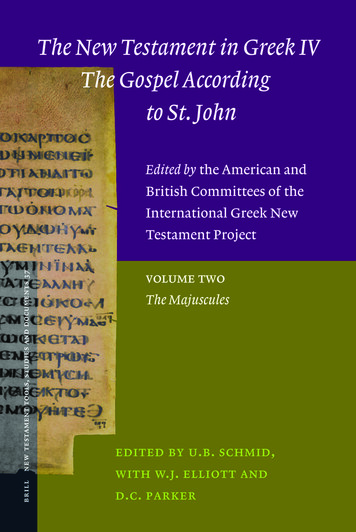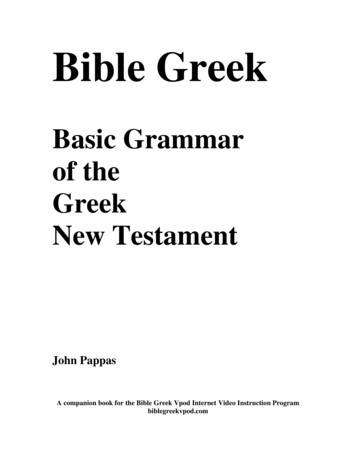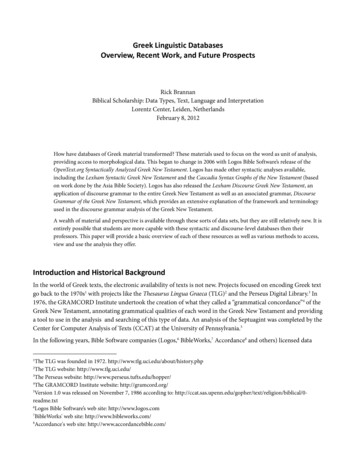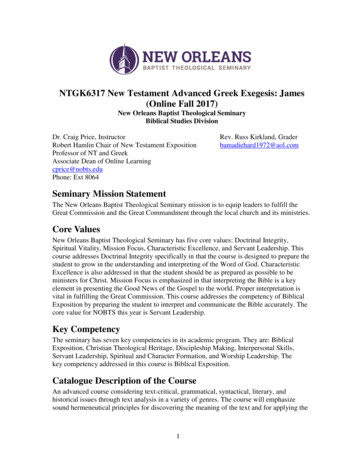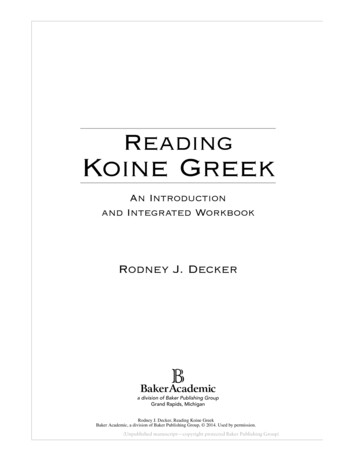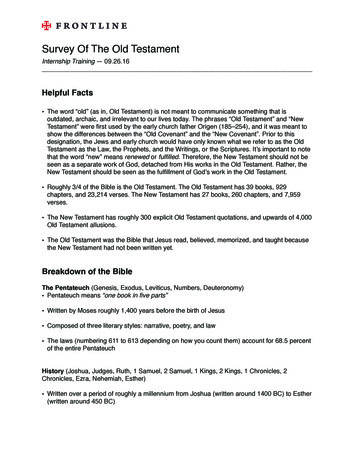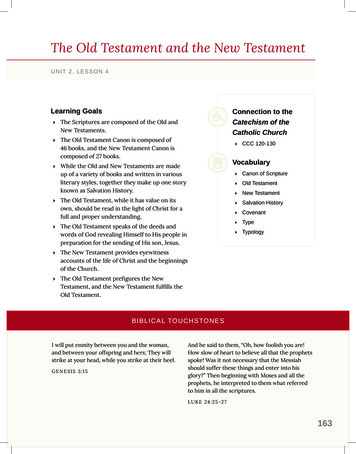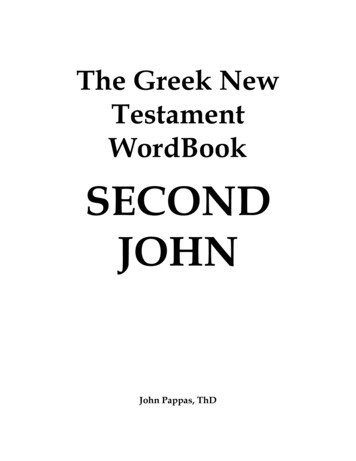
Transcription
The Greek NewTestamentWordBookSECONDJOHNJohn Pappas, ThD
Copyright, 2014John P. Pappas, ThM, ThDii
Table of ContentsPreface. ivIntroduction . 6Greetings (1-3) . 10Walk in truth (4-6) . 18Many Deceivers (7-8) . 25Do Not Receive Deceivers (9-11) . 34Farwell (12-13) . 40Detailed Analysis . 44Bibliography . 49iii
PrefaceThis work is designed specifically for the person that has had one year of New TestamentGreek. A need was identified for a work that is focused upon the needs of the second yearstudent and those that desire a deeper look into the text. The format is exegetical andmeant to not only bring out the “richness” of the language, but also the emotional senseof the text.The Greek of the New Testament is rich with Hebrew expression and the pictorialnature of the Semitic language. It is not a mistake that the great Greek grammarian A.T.Robertson named his work “Word Pictures of the Greek New Testament.” The wordpictures drawn from Scripture are primarily Jewish in character, so it is that the NewTestament is replete with Hebrew “word-pictures.” It is also important to note in anyoriginal historical work the logic and historical setting involved. Thus, this work is titled“The Greek New Testament Wordbook,” and the focus is placed upon the Greeklanguage as it relates to historic New Testament usage.The following guidelines are used throughout the work:1.2.3.4.5.6.Use the original language separated by phrases.Keep the word order as close to the original as possible.Parse all the verbs.Find all word derivations.Translate the basic, fundamental grammar constructs as much as possible.Keep the translation as raw and literal as possible.This work is not intended as a new translation, or even a good translation, but toenable the user to quickly identify the author’s emphasis using word order, verb tense,mood, voice and number.It is hoped that this work will be a help to students and teachers of the Word so thatone might pronounce more of God’s Word and less of man’s word. This is how it shouldbe.John Pappas,Fort Worth, Texas, 2014iv
IntroductionThe Second Epistle of John, as Dr. Thiessen notes, “is so short and of a private character,it was not circulated as early or as widely as 1 John. Consequently we do not find manyearly quotations of or definite allusions to it.”1 Tradition holds that John was a leader inthe Church in Ephesus after the expulsion of Jerusalem in the years AD 66-70. His homebase of Ephesus was the regional capital of the Roman empire of Asia Minor. The city inthe first century was a major seaport with more than 300,000 people and housed thetemple of Diana, one of the Seven Wonders of the World.While the cultural makeup of the region was Greek in nature, Christianity sochanged the city that a riot broke out because the Christians were no longer buying thesmall silver shrines to the city god, Diana (Acts 19:21-41). Paul had spent three yearsthere; Timothy was later stationed there to give assistance to the local Church and finallytradition holds that John spent his final years there where he write his works.The message of this brief letter is a set of commands. The exhortations are: (1)love one another (v.5); (2) watch out lest you lose your reward (v.8); (3) do not supporttraveling heretical Christian leaders (v. 10); and (4) be prepared for the apostle’s visit.2AuthorThe author’s identification is nowhere found in the letter. However, history and traditionholds that the apostle John wrote First, Second, & Third John. It is clear that the writingstyle is uniquely John. One could easily examine the evidence of the writing style andwords and conclude the apostle John is the author and indeed history has titled the workas.It should be noted “toward the end of the fourth century Jerome mentions theascription of these epistles to John the Elder rather than the Apostle. Only at a laterperiod were they received in the Syriac-speaking church.”3 It seems silly to separate Johnthe apostle from John the Elder, since Peter calls himself an apostle in 1 Peter 1:1, and hecalls himself a fellow-elder in 5:1. If Peter can do call himself both apostle and elder,why can’t John?In identifying the author, we look at both the internal and external evidence.External evidenceIrenaeus attributes the letter to John the disciple of the Lord. He quotes 2 John 7-8, and11. Origen had doubts concerning 2 and 3 John, but as Dr. Harrison says, “he does not1Henry Thiessen, Introduction to the New Testament (Peabody: Hendrickson, 2002), p. 311Clint Arnold, gen. ed., Zondervan Illustrated Bible Backgrounds Commentary (Grand Rapids: Zondervan,2002), vol. 4, p. 2143Everett Harrison, Introduction to the New Testament (Grand Rapids: Eerdmans, 1982), p. 45026
seem to reject the books on this account.”4 Moreover, Eusebius put this letter among theAntilegomena.A look at the history of declaring Second John authentic whose source is from theapostle John is identified as follows:51. Citation or allusion of 2 John 7 by Polycarp (c. 110-150).2. Called authentic by Irenaeus (c. 130-202), Jerome (c. 340-420), and Augustine (c.400).3. Listed in the following Canons: Muratorian (c. 170), Apostolic (c. 300),Athanasius (367).4. Declared authentic at the following Councils: Hippo (c. 393), Carthage (c. 397),and Carthage (c. 419).The earliest papyrus fragment known, identified as the John Rylands Fragment (P52)dates to A.D. 117-138 and contains John 18:31-33, 37-38. Though, not Second John, thefragment supports the evidence that the apostle John wrote his works around the end ofthe first century.Internal evidenceThe author is only identified as “the elder,” a designation for an old man or what came tobe the office of Church elder. Since the author is not mentioned, one has only style,grammar, and choice of words to help identify who wrote the letter. The internalevidence concerning the author of this little letter concerns first and foremost the style,the words, and the length of sentence. The unique style of John is prominent in the letter.His Jewish thought process and choice of words comes out naturally in this document.Date of WritingThere is nothing in the text to point to a particular date. While some have argued for anearly date, most hold to a late date sometime in the 90s. John was in Jerusalem untilsometime around AD 70 when the fall of Jerusalem brought the Jews to flee the city.According to tradition, John, Philip, and Andrew were among those who fled with theChurch. According to tradition, John moved to Asia Minor and except for his exile inPatmos, remained in Ephesus until his death. Irenaeus claims John to have lived until thetime of Trojan (98-117).It seems reasonable to say that John labored in the Churches, writing his Gospel(around AD 90) and general epistles until about AD 95, and when he was exiled to theisland of Patmos during the Domitian persecution he wrote Revelation. He returned toEphesus about AD 97, and died around the turn of the century. John is said to be the onlyone of the original disciples not to die as a martyr.Place of Writing45Everett Harrison, Introduction to the New Testament (Grand Rapids: Eerdmans, 1982), p. 449Norman Geisler, William Nix, A General Introduction to the Bible (Chicago: Moody Press, 1986), p. 2947
The little letter does not say where the apostle John writes from so in all likelihood it waswritten by John at his home base of Ephesus. Dr. Keener notes, “The length is the sameas that of 3 John; both were probably limited to this length by the single sheet of papyruson which they were written; in contrast to most “New Testament letters, most otherancient letters were of this length.”6 Indeed, this letter provides us an example of aconvention letter-form of the contemporary Graeco-Roman world.AudienceThe apostle is writing to the household in the province of Asia connected with the “electlady and her children.” Some take the elect lady to be an individual lady and herhousehold. Others, however, take the “elect lady” to be a Church. Those arguing that the“elect lady” is an individual point to the singular used in verse 5. However, the pluralsused in verse 8, 10, and 12 favor an interpretation for a Church.Major themeThe major theme might be verse 6 – “this is love, that we walk after Hiscommandments,” and continuing that theme is the command of verse 9 to abide in thedoctrine of Christ. The apostle points out his appreciation of the loyalty of the lady andher children (verses 1-4), but warns her against traveling false teachers (verses 7-11). Heexhorts her not to be hospitable to these deceivers and to reject them completely (verses10-11).The false teachers are teaching the Gnostic heresy that Jesus Christ did not comein the flesh (verse 7), the same heresy addressed in first John. These deceivers must beavoided. The first six verses focus on the positive using words like, “love” and “truth,”whereas the last part of the letter focuses on the negative.2John OutlineI. Abide in God’s commands (1-6)1. Greetings (1-3)2. Exhortation to walk in truth (4)3. Exhortation to walk in love (5-6)II. Do not abide with false teachers (7-13)1. Warning again false teachers (7-9)2. Avoid false teachers (10-11)3. Farewell (12-13)6Craog Kenner, The IVP Bible Background Commentary: New Testament (Dowers Grove: IntervarsityPress, 1993), p. 7478
9
Greetings (1-3)2 John 1-311The elder to the elect lady and herchildren, whom I love in the truth; andnot I alone, but also all those who haveknown the truth. 2For the truth, the onethat remains in us. Also will be with usforever. 3Grace, mercy, [and] peace willbe with us from God the Father, andfrom the Lord Jesus Christ, the Son ofthe Father, in truth and love.23IntroductionUnlike the Apostle John’s first letter to the Church, this second letter is addressed in thestyle of a personal letter to an individual. This personal greeting is most certainlycommon to the period. The Christian’s greeting, however, differs in its definitions ofgrace and peace. The world around them is pagan, their definition of grace and peace issomewhat empty. For the Christian, grace, mercy, and peace have a specific meaning.That is to say, these words have a special meaning and have turned into precisetheological terms.The definition of words finds a difference in one’s worldview. For those belovedof God, the meaning of God’s love, agapē love, is a love that gives and asks nothing inreturn, it is faithfull, and in a Jewish sense means “an unspeakable love and tender10
mercies of God in covenant with God.”7 The meaning of mercy is one that speaks of aGod who has taken the sins of the world upon His own death on the cross as the perfectsubstitute for us, thus bringing reconciliation to peace and us as we live out our new lifeidentified with Him. We are Christians, and along with the wonderful gift of forgivenessis personal responsibility as we live as representatives of the calling. We are identified asChristians.Personal greetings (1-3)1.(The elder to the elect lady and her children whom I love in the truth). The apostle Johnidentifies himself as the presbuterov (presbuteros) adj. n.m.sg., with def. art., “theelder,” or “the old man.” Indeed, John was an old man at the time of writing as he is mostlikely in his 90s. But is this a reference to his age, or to his position as an official “elder”of a Church? It seems most likely he is speaking as an elder in the Church, becausetradition says he was a leader in the Church at Ephesus, and the letter’s content is anexample of what an elder might say in this situation. The definite article used with theadjective also gives some indication as to his position as it serves to further define theauthor as a noun, that is, his position as “the elder.” As Dr. Lenski says, “He is ‘thePresbyter’ in the sense that this title belongs only to him.”8 At least that is what the earlyChurch father Papias, the 2nd century bishop of Hierapolis, called John the apostle.This letter is specifically directed toward the “elect lady” whose identity is not9given . This eklekth kuria has traditionally been interpreted as either a real person, ora Church. The adjective eklektov (eklektos) adj.d.f.sg., “picked out one,” “chosenone,” or “elect one,” is from the compound of ek “out” and legw (lego) “to say, speak”and is literally, “one called out,” or “a called out one.” The feminine adjective “elect”modifies Kuria (Kuria) d.f.sg., “lady,” and the dative is the case of reception, thusidentifing her as the receiptant of this personal letter.The feminine term Kuria is used only here in the New Testament and means“lord, master.” The feminine form most likely has to do with her position as “lord” or“owner” over the house. There are two ways to interpret this lady of the house: (1) a reallady; and (2) a Church (see the comments in verse 13). John addresses both the lady kai(“and”) the teknon (teknon) d.n.pl., with def. art., “the offspring,” or “children,” ofautov (autos) pers. pron. 3g.f.sg., “her.” That is, these are children of a kuria – awoman head of household or Church. The word Kuria is a woman of special status in7William Wilson, Wilson’s Old Testament Word Studies (Peabody:Henderickson, no date), p. 260R.C.H. Lenski, The Interpretation of the three Epistles of John (Minneapolis: Augsburg Publishing,1966), p. 5549Some claim her name is in fact Kyria (or Cyria).811
charge of a household, the LXX uses the word to designate the mistress as opposed to theslave10.The apostle has a personal knowledge of her and her household because headdresses them in this letter in an intimate way. He refers to them collectively with themasculine pronoun ov (hos) rel. pron., a.m.pl., “whom” I love in the truth. It is commonto express a group that possesses both male and female in the masculine. The expressionegw agapw en alhyeia signifies what manner of affection he has for them. Not onlydoes John agapaw (agapao) Pres. Act. Ind. 1sg., “love” them in the truth, but they alsotogether love in truth. That is to say, they gather around and share the common ground offellowship in “the truth” – God’s word. They are collectively in the truth. The prepositionen can be locative (position), or instrumental (by means of), in the alhyeia (aletheia)d.f.sg., “truth.” The root meaning of en, however, is “within” the realm of truth, or assome say, “in connection with the truth.”The word “truth” is used by John in a particular way. He sees God as truth andindeed the Word as truth. Truth and the Word of God are synonymous. So it is, that theygather around the Word of truth, but by using the word “truth” in the introduction, Johnintends to bring her Biblical guidance by the word of truth. They stand on commonground on the truth, so John can speak truth to her in the truth. It should be noted that“the truth” might also be in reference to the Spirit of Truth – the Holy Spirit that theyshare in a common indwelling presence. They know the truth because they have the Spiritof Truth dwelling in them.(and not I alone, but alsoall those who have known the truth). John includes kai ouk egw monov “and not Ialone.” Indeed, he is not alone in this truth. The conjunction kai might better betranslated emphatically as “indeed.” The personal pronoun with the negative particle oubuilds the argument that he indeed is not alone. The adjective modifying the personalpronoun is in the nominative case serving to identify John as being in a group, for he isnever monov (monos) adj.n.m.sg., “alone,” or the “only one.” The conjunction alla(alla) “but,” forms a transition to the matter at hand, that is, they are all togethercollectively in a group, those that have known the truth. You might say, they are alltogether the people of the truth – the people of the Word of God. This is highlighted bythe adjective pav (pas) adj.n.m.pl., “all,” that modifies the participle ginwskw (ginosko)Perf. Act. Part. n.m.pl., with def. art., “those that have known” the alhyeia (aletheia)a.f.sg., with def. art., “the truth.” The participle with the definite article speaks of acommon group that has known the truth – they are identified as the people of the truth –they are most likely Christians everywhere.A Christian is spoken of in John using the participle as (1) people of the truth (cf.2 John 1:1; 3 John 1:4); (2) people of the love (cf. John 14:21; 1 John 2:10; 4:21); and (3)people doing righteousness (1 John 2:29). The participle can identify who a person is. Itanswers the question: what is their occupation? The natural response is, they areChristians. Being in Christ is what defines them. A Christian is one that has beenconvicted by the Spirit of the truth of the gospel of Christ – that Jesus came in the flesh,10BDAG, A Greek-English Lexicon of the New Testament and other Early Christian Literature (Chicago:Chicago Press, 2000), 57612
died as the Lamb of God as a substitute for one’s sins, and was raised from the dead asthe first-fruits of the resurrection. That truth lives in us because it is through the Word ofGod and the Spirit of God that moves in the believer to believe, for it is the work of God(John 6:28-29). The result of that work of God is a person who has put on new workclothes, a metaphor related to baptism - it is a new mode of life, a new identity withChrist and eternal havingbelievingThe Christian described participially in John’s writings (substantive use)“a person known as one who ”VerseTextParsingResult1 John 4:6one that knows GodPres. Act. Part.listens to usn.m.sg., with def. (believers – thoseart.possessing thespirit of truth)2 John 1:1Those that have known thePerf. Act. Part.are loved in thetruthn.m.sg., with def. truthartJohn 14:21one that loves Me (Christ)Pres. Act. Part.will be loved byn.m.sg., with def. My Fatherart.1 John 2:10he that loves his brotherPres. Act. Part.abides in the lightn.m.sg., with def.art.1 John 4:21he that loves GodPres. Act. Part.loves his brothern.m.sg., with def. alsoart.1 John 2:17the one doing the will of God Pres. Act. Part.abides [in God]n.m.sg., with def. foreverart.1 John 2:29the one doing righteousnessPres. Act. Part.is born of himn.m.sg., with def. [God]art.1 John 2:23the one confessing the SonPres. Act. Part.has the Fathern.m.sg., with def.art.1 John 4:16the one that abides in the love Pres. Act. Part.abides in God[God’s love]n.m.sg., with def.art.2 John 1:9he that abides in the doctrinePres. Act. Part.has both the Fatherof Christn.m.sg., with def. and Sonart.1 John 5:12the one that has the SonPres. Act. Part.has the lifen.m.sg., with def.art.1 John 5:5he that believes that Jesus isPres. Act. Part.is the one thatthe Son of Godn.m.sg., with def. overcomes theart.world1 John 5:10he that believes on the Son of Pres. Act. Part.has the witness inGodn.m.sg., with def. himself13
art.2.(For the truth, the one that remains in us).The preposition dia (dia) “through,” is properly in the accusative “because of the truth,”or “for the sake of the truth,” reflecting the cause. They are loved in truth because thesubject, alhyeia (aletheia) a.f.sg., with def. art., “the truth” remains in them. We share ina common truth. “The truth” is a specific truth as is pointed out by the definite article,signifying a specific truth. The participle menw (meno) Pres. Act. Part. a.f.sg., with def.art.,”to remain, abide,” and is translated, “she/it [the truth] that remains” or “the truthwhich remains in us.”As with First John, they know the truth because the truth is in them (cf.John16:13; 1 John 3:18-19; 5:10; 3 John 3), so it is true that they love in this truth becausethey remain in this same truth. The better idea is that of abiding. This is the doctrine ofabiding found extensively in 1 John (cf. 1 John 2:6). The abiding involves the permanentindwelling of the Holy Spirit as truth is synonymous with God as the Spirit of Truthguides men into all truth. His presence en hmin (in us) is qualified elsewhere as a seal (cf.Eph. 4:30) – never to be broken. God is truth, purer than the finest refined gold is true,likewise, God’s word is true and everlasting just as His Spirit, the Spirit of truth (cf. John14:16; 15:26; 16:7) indwells forever! We find that what John is speaking about here is“the truth” that comes from the Spirit that is within those that believe.(also will be with us forever). The doctrine of eternalsecurity is found many places in Scripture and its fundamental character lies in the verycharacter of God Himself. There is only One that is true, trustworthy and eternal; thatperson is God, and He alone. To say the believer has eternal life is to also say he haseternal security the moment he is declared righteous by God. The fundamental reason hasto do with the character of God. We are secure because God has set us apart to Him. Hehas given us His Spirit as a seal until the day of redemption (Eph. 4:30) and no one cantake us out of His hands (John 10:28-30). The conjunction kai is better translated “also,”or emphatically as “indeed.” The position of the preposition meta (meta) “with,” at thehead of the phrase serves to emphasize that the truth is positionally with us. The genitivepronoun egw which follows limits the preposition to association, manner, or spatialposition. That is to say, the truth that remains in us also will be “in our midst” forever.The future verb eimi (eimi) Fut. Mid. Dep. Ind. 3sg., “it will be,” provides thecontrolling tense of the present participle, moving the sense to be: the truth that iscurrently in us, will continue to be in us for all time. The time aspect is indeed eiv tonaiwna (into the age). The Greek aiwn (aion) a.m.sg., with def. art., “for ever, eternity,age” is important as it has the Jewish sense of into “the age” to come, namely, the eternalstate (age).Verse1Textwhom I love in the truthTruth in 2 JohnControlling verbαγαπαω “to love”14Verb tensePres. Act. Ind.
1those that have known the truth2the truth that abides in us34“greeting” in truth and loveI have found walking in thetruthγινωσκω “to know”Perf. Act. Part.n.m.pl.μενω “to remain,Pres. Act. Part.abide”a.f.sg.ειμι “to be, exist”Fut. Ind.περιπατεω “to walk” Pres. Act. Part.a.m.pl.3.(Grace, mercy, [and] peace will be with usfrom God the Father, and from the Lord Jesus Christ, the Son of the Father, in truth andlove). The apostle’s closing greeting is in typical fashion for the day as he uses the wordsgrace and peace. The construction estai mey hmwn cariv (grace will be with us),includes the future deponent verb from eimi (eimi) Fut. Mid. Ind. Dep. 3sg., “he/she/itwill be.” The time aspect seems to be “now and forever,” since John could have used thepresent tense, but he chose not to. The word cariv “grace” has the meaning “of themerciful kindness by which God, exerting his holy influence upon souls, turns them toChrist, keeps, strengthens, increases them in Christian faith, knowledge, affection, andkindles them to the exercise of the Christian virtues.”11This specific construction for the Christian should not be taken lightly as gracestarts as “unmerited favor” by God toward those He has predestined, called, justified andglorified (Rom. 8:30). The starting point of grace has to do with sovereign election andjustification, as those He calls are placed into the family of God, then grace moves to thesanctification side of one’s new life, thus favor results in a daily walk that ischaracterized by truth and light in the believer.Notice the preposition used with the genitive is meta (meta), thus stressing thespatial meaning of “with,” or “among” hmwn “ us.” This cariv (charis) n.f.sg., “grace,”or “favour” is directed toward the child of God as his or her relationship with God theFather, and God the Son, is one of reconciliation not enmity due to the work that Christdid on the cross.The words eleov (eleos) n.n.sg., “mercy,” and eirhnh (eirene) n.f.sg., “peace,”are directed from para (para) Father God (yeov: g.m.sg.; pathr: g.m.sg., father) andJesus Christ. The conjunction kai “and,” together with the repeated preposition para“from” suggests both the Father and the lord Jesus Christ are equal as they both are thesource of mercy and peace. Further, the preposition para used with the ablative speaksof source, as the Godhead is the source of grace, mercy and peace.The addition of kuriov (kurios) g.m.sg., “lord,” or “master” to Jesus’ name isimportant. It serves to clarify Jesus as “the lord” spoken of in the Old Testament. TheHebrew is ‘Adonay “my Lord” and is used of men and God. When used of God, it is a“Lord-title,” spoken in place of Yahweh in a Jewish display of reverence.For example,11Online Bible Lexicon, www.onlinebible.net.15
Blessed be the Lord [‘Adonay], who daily bears our burden, the God who is our salvation.Selah. (Ps. 68:19)But You, O Lord [‘Adonay], are a God full of compassion, and gracious, longsufferingand abundant in mercy and truth. (Ps. 86:15)Therefore the Lord [‘Adonay] Himself will give you a sign: Behold, the virgin shallconceive and bear a Son, and shall call His name Immanuel. (Isa 7:14)Hear and testify against the house of Jacob, Says the Lord [‘Adonay] GOD, the God ofhosts, (Am. 3:13)The Lord Jesus Christ is in essence the Lord of Salvation, the Messiah, and veryGod. He is the Son of the Father. This identification is an expression of deity (cf. Ps. 2).There is great confusion concerning the Trinity as the cults continue to chip away at thesimple definition of God in three persons – the Father, the Son, and the Holy Spirit. Howgreat it is to see the truth of the Trinity throughout Scripture. In fact, when the Jewishleadership heard the term “Son of God,” they understood it to mean Jesus was claiming tobe God (cf John 5:17-18). When asked to clarify who He was, Jesus replied, “For as theFather raises the dead and gives life to them, even so the Son gives life to whom He will”(John 5:21).It is no mistake that the Immanuel of Isaiah (Isa. 7:14) is named Jesus in Matthew(Matt. 1:21). Jesus is in the Greek Ihsouv (Iesous) g.m.sg., and is of Hebrew origin fromewvwhy (Yehoshua’) Joshua “Jehovah is Salvation.” This describes His first coming workon the cross. He is indeed the Anointed Savior of the Old Testament. The GreekCristov (Christos) g.m.sg., means, “anointed” and is equivalent to the Hebrew“Messiah.” The expression finds it deepest meaning in the future Messianic kingdom asthe Jews look forward to finding rest from the persecution of the nations. A kingdomdescribed as full of righteousness and peace. A place where lion will lay with lamb.Where the nations will no longer roar against Israel.The expression “Son” is a confusing word for the English-speaking person. Themeaning of son does have a “progentator” meaning, but has the primary meaning is oneof inheritance and a legal heir with all the attributes, rights and responsibilities of thefather. The Greek uiov (huios) g.m.sg., with def. art., “the son,” has the idea of havingpathr (pater) g.m.sg., with def. art., “the father” in relationship and character ascompared to teknon used above which stresses birth. Jesus is the Son of Man, the Son ofGod, and the Son of David, because He alone is the unique One that represents man andGod in the legal transaction that took place on the cross as the perfect Lamb of God thattook away the sin of the world. He alone represents the throne of David and God in thelegal transaction for the Messianic Kingdom at His second return.God does all this because He alone defines truth and love. So it is that Johndeclares this greeting, en alhyeia kai agaph “in truth and love.”16
17
Walk in truth (4-6)2 John 4-64I rejoiced greatly because I found yourchildren walking in truth, even as wereceived a command from the Father.5And now I ask you, lady, not as I writea new command to you, but what we hadfrom [the] beginning that we might loveone another. 6And this is the love: thatwe might walk according to thecommands of Him. This is thecommand, just as you heard from [the]beginning, that you should walk in it.4IntroductionIf it is important for the Christian to know the truth, then it is equally important for himor her to defend the truth. After establishing that they know the truth in his greeting, nowthe apostle encourages them to walk in the truth. To say there is truth is to search theScriptures. To say there is love is to also search the Scriptures. However, one finds thatthe love of God has its highest application as it applies to faithfulness to the will of God.And further, to say, “follow My commands” means we are to walk in truth faithfullyseeking and doing God’s will.He commands His people to love those in His Church, because it is so hard tocontinue loving people who are fickle, who are so faithless, and stiff-necked that truthand love in their lives is hard to find. However, God does not give us an option! He saysto love them, to love truth, and to carry out our lives characterized by both truth and love.The two most important words in this little letter are truth and love. If inde
"The Greek New Testament Wordbook," and the focus is placed upon the Greek language as it relates to historic New Testament usage. The following guidelines are used throughout the work: 1. Use the original language separated by phrases. 2. Keep the word order as close to the original as possible. 3. Parse all the verbs. 4. Find all word .


